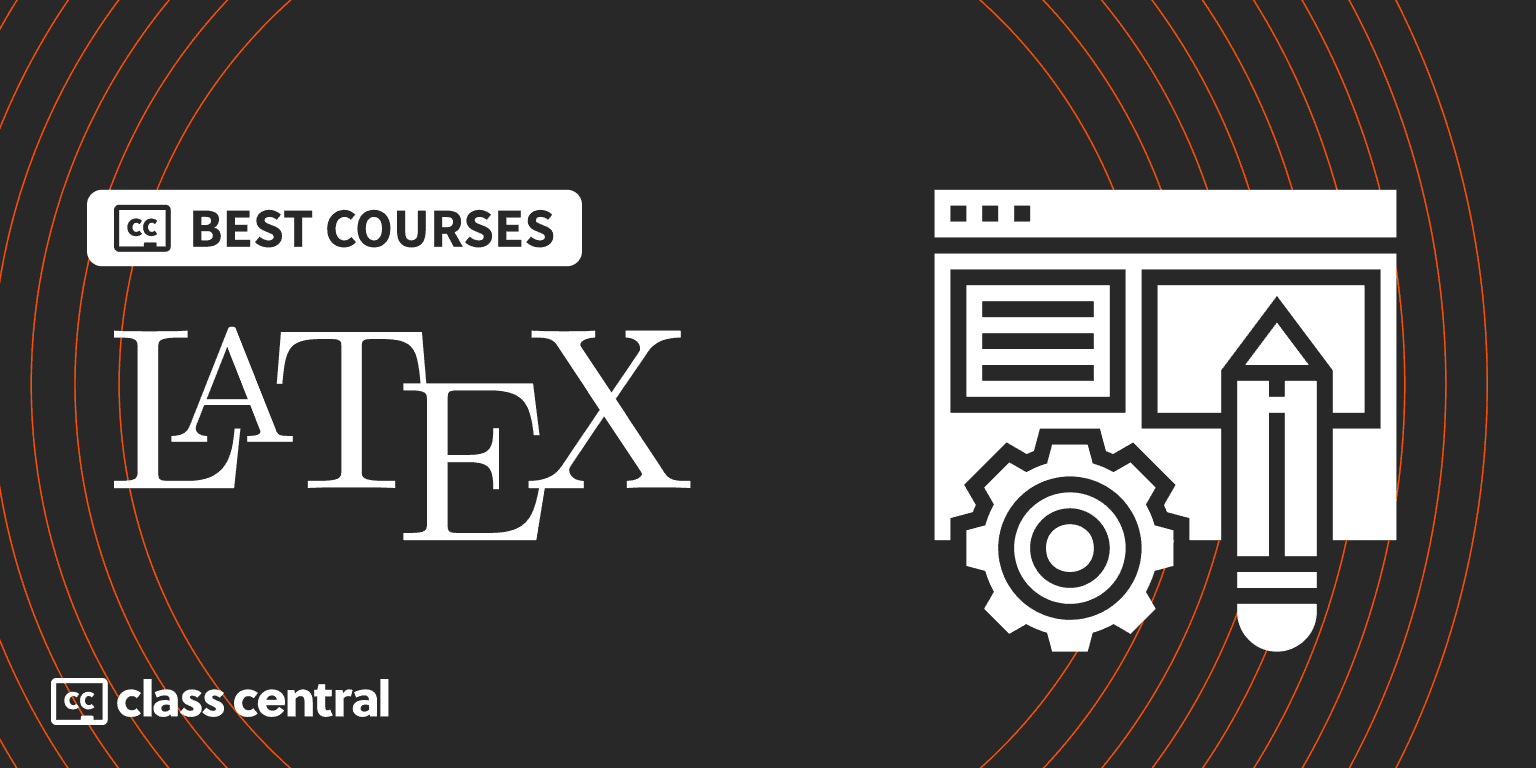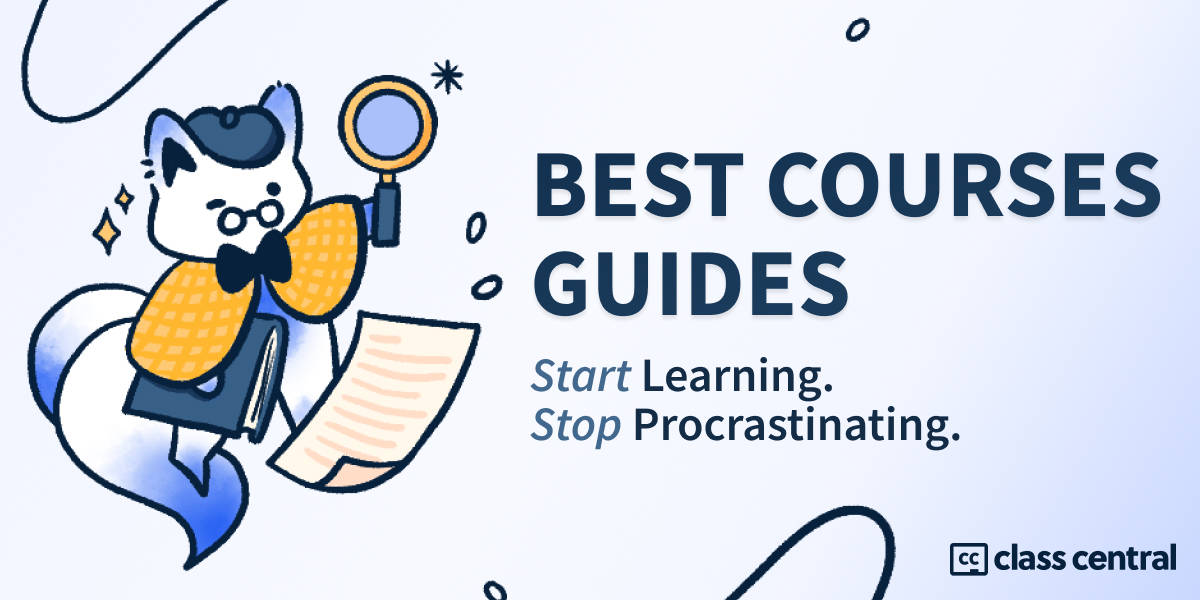9 Best Free LaTeX Courses for 2025
Master the Art of Typesetting with the top free LaTeX courses.

If you’ve clicked on this BCG (Best Courses Guide), you’re probably a university student, a lecturer, researcher, or perhaps an avid math fan who wants to take their document preparation skills to the next level. And let me tell you, you’ve come to the right place!
LaTeX is a powerful yet flexible document preparation system with almost 4 decades of history. Almost all math papers are written in LaTeX thanks to its extensive support for whatever arcane-looking runes and symbols mathematicians manage to come up with. According to a study, approximately 26% of submissions to scientific scholarly journals are written in LaTeX.
At its core, however, LaTeX is a markup language. That means instead of having whatever you type immediately appear on the page like Microsoft Word (WYSIWYG), you write commands that then need to be compiled to display an output file. This may be a little intimidating at first, especially if you’ve never used markup or programming languages before, but with the right guidance and training, anyone can learn to use LaTeX like a pro!
Hence, I’ve compiled the best courses to learn LaTeX in this guide. Whether it’s for math, engineering, or science, or maybe you just like pretty documents, I’ve got you covered!
Click on the shortcuts for more details:
- Top Picks
- What is LaTeX?
- Why You Should Trust Us
- Courses Overview
- How We Made Our Picks and Tested Them
Here are our top picks
Click to skip to the course details:
| Course Highlight | Workload |
| Best Free Course for Learning LaTeX Core Functions (learnlatex.org) | N/A |
| Also Great Course for Learning LaTex Core Functions (Andrew Roberts) | N/A |
| Best Free Well-Rounded LaTeX Course for Mathematicians (freeCodeCamp) | 4–5 hours |
| Best Free Short Course for Mathematicians (The Math Repository) | 1–2 hours |
| Best Free Comprehensive Course for STEM Students (IIT Bombay) | 21–28 hours |
| Best Free Short Course to Learn the Bare Minimum to Get Started (Trefor Bazett) | 30 mins |
| Best Free Short Text-Based Course to Learn the Bare Minimum to Get Started (Luong Vo) | N/A |
| Best Simple LaTeX Guide for Engineers (Xiong Ying) | N/A |
| Best Free Course with Practical Exercises (University of Amsterdam) | N/A |
What is LaTeX?
LaTeX is a document preparation system that enables users to produce high-quality documents with a focus on content over appearance.
Its origins can be traced back to the 1970s, when the legendary computer scientist Donald Knuth created Tex, a new typesetting system whose purpose was “to make a system that’s so simple that you can’t possibly do anything ugly in it”.
He succeeded in one of his goals: you can’t do anything ugly in TeX. However, many people thought that TeX was too complex and difficult to use. So, a decade later, Leslie Lamport set out to create a new document preparation system that leverages the powerful TeX engine while simplifying its use. And thus, LaTeX (short for Lamport TeX) was born, consisting of macros and templates that make it easier to produce complex documents with consistent formatting and style.
Templating a document, structuring sections, generating complex mathematical equations and formulas—features once thought to only belong to experts—are now at the fingertips of anyone with the will to learn. You have precise control over all things. Additionally, LaTeX introduced new features like bibliographies, making it an attractive option for academics and researchers, particularly mathematicians. Even we here at Class Central have used LaTeX in our Udemy paper.

Thanks to the thriving LaTeX community, there are countless packages available to meet a wide range of needs including babel, TikZ, and Beamer. LaTeX is widely used worldwide for technical and scientific documents, from research papers and academic theses to books and even presentations! And despite the emergence of other document preparation systems, LaTeX still remains a popular choice for those who require precise and professional-looking output decades later.
Why You Should Trust Us
Class Central, a Tripadvisor for online education, has helped 60 million learners find their next course. We’ve been combing through online education for more than a decade to aggregate a catalog of 200,000 online courses and 200,000 reviews written by our users. And we’re online learners ourselves: combined, the Class Central team has completed over 400 online courses, including online degrees.
Courses Overview
- All of the courses are suitable for beginners
- All of the courses are free
- Three of the courses in this guide are made by mathematicians, for mathematicians
- The most represented provider is YouTube, followed by edX and then independent providers.
Best Free Course for Learning LaTeX Core Functions (learnlatex.org)
Built and led by the members of the LaTeX project themselves, learnlatex.org is a free course that is one of the most helpful and up-to-date introductory LaTeX courses available.
This course is designed for absolute beginners, covering the essential ideas behind core LaTeX packages and classes. Thus, while the course is limited in scope, sticking only to the base concepts, it nonetheless gives newbies a strong foundation in LaTeX to write mathematical equations, insert graphs and figures, and generate reports through bite-sized article lessons, interactive code examples, and exercises. Laying a solid foundation is crucial since you can’t use custom packages properly without knowing how to use the core ones.
The course is LaTeX distribution agnostic, and doesn’t use any specific LaTeX editor, though the code examples can be run with either Overleaf or TeXLive.net.
In this course, you’ll learn:
- Basics of LaTeX, including setup with a TeX system and text editor
- Document structure and essential commands for formatting content
- Techniques for inserting graphics, referencing figures, and generating tables
- Creating and formatting mathematical equations with the amsmath package
- Managing long documents by splitting sources into smaller files
- Understanding Unicode input and common LaTeX errors
- How to seek help from LaTeX documentation sources.
This course has been translated into 8 other different languages: Catalan, German, Spanish, French, Italian, Marathi, Portuguese, and Vietnamese. Native language speakers rejoice!
| Institution | LaTeX Project |
| Provider | learnlatex.org |
| Author | Joseph Wright and David Carlisle |
| GitHub | 143 stars |
| Level | Beginners |
| Exercises | 16 practical exercises and examples |
| Workload | N/A |
| Certificate | None |
Also Great Course for Learning LaTex Core Functions (Andrew Roberts)
Getting to Grips with LaTeX is a free tutorial series written by Andrew Roberts. It covers the common questions and problems most beginners face when they start learning LaTeX.
You’ll get up to speed with everything you need to create polished and professional documents in no time.
No knowledge of LaTeX is assumed prior to starting this course. This course however does not teach you about LaTeX editors, so you’ll have to set that up yourself.
What you’ll learn:
- Basic structure of a LaTeX document through a “Hello World!” example
- Creating articles with structured content, lists, tables, and bibliographies
- Importing and formatting images, including adding captions and text wrapping
- Formatting document contents such as fonts, paragraphs, footnotes, orientation, margins, columns, and headers
- Writing mathematical equations and expressions, from basics to advanced topics like equation alignment
- Producing a table of contents and customizing PDF outputs with PDF-specific features.
| Website | andy-roberts.net |
| Instructor | Andrew Roberts |
| Level | Beginner |
| Workload | N/A |
| Certificate | None |
Best Free Well-Rounded LaTeX Course for Mathematicians (freeCodeCamp)
Do you want to learn LaTeX for writing math papers? LaTeX – Full Tutorial for Beginners is for you.
Created by Michelle Krummel, an experienced teacher with multiple mathematics degrees, This free series teaches beginners the fundamentals of creating LaTeX documents for mathematics: formatting documents, writing equations, inserting figures, etc. You’ll even learn how to create a Beamer slide presentation!
This course recommends the Overleaf LaTeX editor for online use, though for working offline the course uses the TeXmaker editor which she uses throughout the course.
As for LaTeX distributions, MiKTeK is recommended for Windows users, whereas for Mac users it’s MacTeX.
What you’ll learn:
- Basics of building and formatting LaTeX documents
- Writing mathematical equations and notation, including superscripts, subscripts, and Greek letters
- Creating and modifying tables, arrays, enumerated, and itemized lists
- Inserting and customizing graphics using various packages
- Document formatting, including fonts, text justification, and table of contents creation
- Finding and fixing compilation errors
- Advanced math formatting for calculus notation: limits, integrals, summations, and vectors
- Creating Beamer slide presentations for professional presentations.
| Organization | freeCodeCamp |
| Provider | YouTube |
| Instructor | Michelle Krummel |
| Level | Beginners |
| Exercises | Sample source (.tex) and output files (.pdf) |
| Workload | 4–5 hours |
| Views | 503K |
| Likes | 11K |
| Certificate | None |
Best Free Short Course for Mathematicians (The Math Repository)
Just Enough LaTeX to Survive is another free LaTeX course meant for math students, but much shorter than the previous one.
It tries to balance getting things onto the page with an understanding of the overall structure of LaTeX. Hence, it opts for a slideshow style to teach the basics of LaTeX piece by piece, so no LaTeX editor is shown in this course.
You’ll be introduced to some essential LaTeX packages for writing mathematical expressions (asm) and drawing graphs (TikZ). You’ll also learn how to make slideshows like the one he’s using with Beamer.
What you’ll learn:
- Basics of formatting and manipulating text in LaTeX
- Using LaTeX environments for different typesetting effects
- Writing basic and advanced mathematical notations, including calculus
- Creating and customizing tables and arrays
- Utilizing TikZ for creating precise figures, graphs, and shapes
- Creating professional-looking presentations with Beamer.
| Channel | The Math Repository |
| Provider | YouTube |
| Level | Beginners |
| Workload | 1–2 hours |
| Views | 10K |
| Certificate | None |
Best Free Comprehensive Course for STEM Students (IIT Bombay)
LaTeX for Students, Engineers, and Scientists is a free course that introduces the basic concepts of LaTeX with videos and articles. You’ll start by creating a basic document using LaTeX and then moving on with formatting pages, text, creating tables, adding images, citing, cross-referencing, and more. Each topic starts with an already formatted PDF document and you’ll gradually learn enough LaTeX to replicate the document format on your own. The course concludes by creating presentations using Beamer.
Note that this edX course is archived, so some of the functionalities (e.g, quizzes and exercises) may not be available.
The course uses TeXstudio as its preferred editor.
There are no prerequisites for this course.
What you’ll learn:
- Basics of creating and organizing LaTeX documents
- Formatting pages, including margins, headers, footers, orientation, and columns
- Writing and formatting mathematical equations and formulas
- Adding and modifying tables and images
- Using hyperlinks, cross-referencing, and creating an index and bibliography
- Creating presentations with Beamer.
| Institution | Indian Institute of Technology Bombay |
| Provider | edX |
| Instructors | Deepak B. Phatak, Firuza Karmali (Aibara) and Nagesh Karmali |
| Level | Beginners |
| Workload | 21–28 hours |
| Certificate | None |
Best Free Short Course to Learn the Bare Minimum to Get Started (Trefor Bazett)
Do you already know some LaTeX and want to quickly get started writing a thesis already?
Trefor Bazett’s free LaTeX tutorial does exactly that in under 30 minutes! You’ll start from a blank page and learn all the things needed to write a thesis, such as tightly controlling a consistent look over an entire thesis, keeping track of numbering, formatting equations, inserting figures, and referencing sources.
He uses Overleaf as his LaTeX editor to write a thesis.
Some experience with LaTeX is required to take this course.
What you’ll learn:
- Understanding LaTeX’s project structure and document classes
- Writing and formatting title pages, abstracts, dedications, and acknowledgements
- Managing large documents by separating chapters into different source files
- Handling appendices and inserting multiple figures with a list of figures
- Creating a bibliography and citing references in various formats
- Adjusting document margins using the geometry package.
If you like this course, there’s more on Dr. Trefor Bazett’s LaTeX tutorials playlist on YouTube.
| Channel | Dr. Trefor Bazett |
| Provider | YouTube |
| Instructor | Trefor Bazett |
| Level | Intermediate |
| Workload | 30 mins total |
| Views | 727K |
| Likes | 18K |
| Certificate | None |
Best Free Short Text-Based Course to Learn the Bare Minimum to Get Started (Luong Vo)
Begin LaTeX in minutes is a free open-source introductory text-based course for beginners to learn LaTeX with ease. It covers many topics in a short amount of time, so if you prefer crash courses over lengthy ones, this course is for you!
The course uses TeXMaker as its preferred LaTeX editor.
No prerequisites are required for this course.
What you’ll learn:
- Creating a single-page “Hello, World!” LaTeX document
- Understanding the structure of a LaTeX file and command syntax
- Writing in multiple languages, including Vietnamese and Chinese
- Organizing documents with lists, paragraphs, sections, and footnotes
- Creating a table of contents
- Using packages to extend LaTeX functionality
- Creating and inserting tables and images
- Inserting code with syntax highlighting
- Dividing a long document into separate files for each section.
This course has also been translated into the following languages: 中文 · Español · Português · Français · Русский · Deutsch · 日本語 · Polski.
| Provider | GitHub |
| Author | Luong Vo |
| Level | Beginner |
| Workload | N/A |
| Stars | 3.2K |
| Certificate | None |
Best Simple LaTeX Guide for Engineers (Xiong Ying)
LaTeX-Tutorial provides free step-by-step tutorials on how to use LaTeX in no time. Aimed towards engineers, it covers LaTeX essentials such as creating and formatting documents and more advanced LaTeX features not found in other beginner courses including automatic table and plot generation, source code highlighting, and circuit diagrams.
By the end of this course, you’ll be able to typeset beautiful documents for your reports, books, and papers.
This course uses no particular LaTeX editor. Additionally, no prior knowledge of LaTeX is required.
What you’ll learn:
- Installing and setting up LaTeX on your machine
- Creating and structuring basic LaTeX documents with sections and paragraphs
- Typesetting equations, matrices, and fractions using packages like amsmath
- Inserting and modifying lists, images, tables of contents, and tables
- Automating bibliographies and footnotes with Bibtex/Biblatex
- Generating tables and plots from .csv files using pgfplotstable/pgfplots
- Adding code snippets with syntax highlighting
- Creating circuit diagrams with circuitikz.
There’s also another course specifically for learning the ins and outs of LaTeX Beamer. Check that out if you’re interested!
| Website | LaTeX-Tutorial.com |
| Author | Xiong Ying |
| Level | Beginner |
| Workload | N/A |
| Certificate | None |
Best Free Course with Practical Exercises (University of Amsterdam)
The biggest reason why University of Amsterdam’s LaTeX course is on this guide is because it’s very practical.
In this free course, you’ll learn the LaTeX basics (as well as some advanced features such as citations, bibliography, and images). An introduction to creating presentations with LaTeX Beamer is also included (with an optional guide on making posters). The course recommends the TeXworks LaTeX editor.
Note that though a majority of the lessons are in English, some are in Dutch.
The course assumes no prior knowledge of LaTeX.
What you’ll learn:
- Basics of LaTeX document typesetting and mathematical formulas using mathtool packages
- Formatting text into sentences, lists, and paragraphs, and troubleshooting typesetting errors
- In-depth exploration of LaTeX file structure with groups, commands, and environments
- Advanced mathematics typesetting, including matrices and references
- Using the uvamath document class for structuring texts with chapters, paragraphs, and tables of contents
- Creating tables and figures
- Making presentations with LaTeX Beamer
- Referencing and citing sources with BibTex and drawing graphical objects with TikZ.
This site is part of the course Programmeren en Experimenteren (Programming and Experimenting) taught at the University of Amsterdam.
| Institution | University of Amsterdam |
| Website | uva-fnwi.github.io |
| Instructor | Jeroen Zuiddam, Jolien Oomens, Chris Zaal, and Raymond van Venetie |
| Level | Beginners |
| Exercises | 14 core + 5 extra lessons |
| Workload | N/A |
| Certificate | None |
How We Made Our Picks and Tested Them
I built this guide following the now tried-and-tested methodology used in previous Best Courses Guides (you can find them all here). It involves a three-step process:
- Research: I started by leveraging Class Central’s database with 200K online courses and 200K+ reviews. Then, I made a preliminary selection of LaTeX courses by rating, reviews, and bookmarks.
- Evaluate: I read through reviews on Class Central, Reddit, and course providers to understand what other learners thought about each course and combined it with my own experience as a learner.
- Select: Well-made courses were picked if they presented valuable and engaging content and fit in a set of criteria: comprehensive curriculum, affordability, release date, ratings and enrollments.
Ultimately, I used a combination of data and my own judgment to make these picks. I’m confident these recommendations will be a reliable way to learn about LaTeX.
Fabio revised the latest version of this article.

Elham Nazif



















Jim
@Fabio What about Markdown?